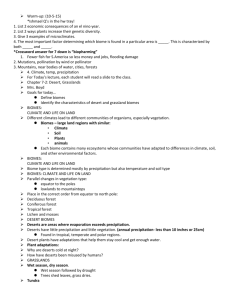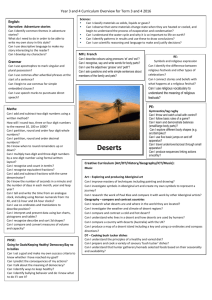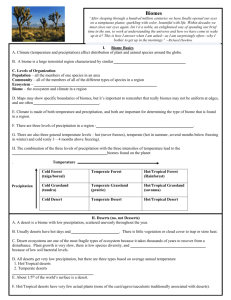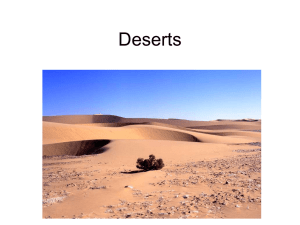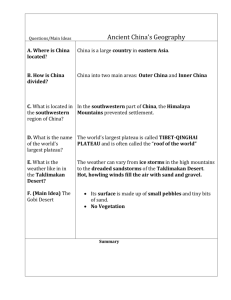File - Leaving Certificate Geography
advertisement
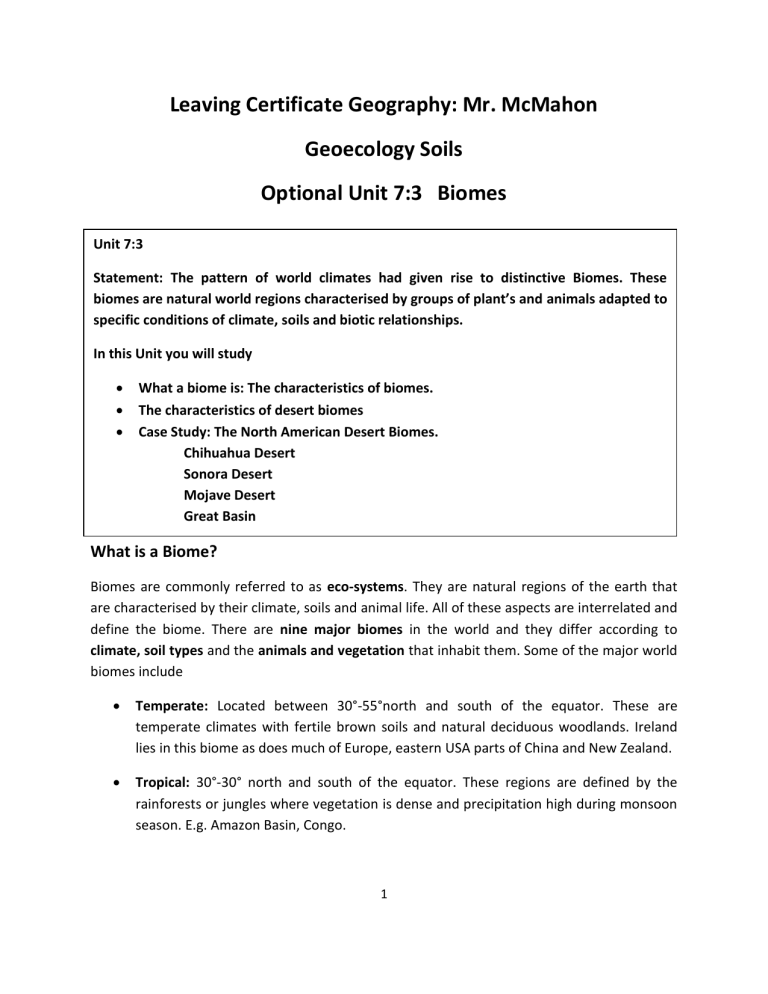
Leaving Certificate Geography: Mr. McMahon Geoecology Soils Optional Unit 7:3 Biomes Unit 7:3 Statement: The pattern of world climates had given rise to distinctive Biomes. These biomes are natural world regions characterised by groups of plant’s and animals adapted to specific conditions of climate, soils and biotic relationships. In this Unit you will study What a biome is: The characteristics of biomes. The characteristics of desert biomes Case Study: The North American Desert Biomes. Chihuahua Desert Sonora Desert Mojave Desert Great Basin What is a Biome? Biomes are commonly referred to as eco-systems. They are natural regions of the earth that are characterised by their climate, soils and animal life. All of these aspects are interrelated and define the biome. There are nine major biomes in the world and they differ according to climate, soil types and the animals and vegetation that inhabit them. Some of the major world biomes include Temperate: Located between 30°-55°north and south of the equator. These are temperate climates with fertile brown soils and natural deciduous woodlands. Ireland lies in this biome as does much of Europe, eastern USA parts of China and New Zealand. Tropical: 30°-30° north and south of the equator. These regions are defined by the rainforests or jungles where vegetation is dense and precipitation high during monsoon season. E.g. Amazon Basin, Congo. 1 Desert Biome: Located between 40°-40° north and south of the equator. Dry arid areas of aridisols and little vegetation. E.g. Deserts of the USA, Sahara, Gobi, and Atacama. Factors that influence the development of Biomes Climate: Climate determines vegetation type. This in turn affects animal life in the region, soil quality and climatic conditions. The main factors are temperature and precipitation. Soils: Soils are the fundamental basis of life in biomes. Soil type and quality is influenced by climate, (weathering, leaching, moisture content) vegetation cover and parent material. Vegetation: Vegetation is influenced by soil quality and levels of temperature and precipitation, Vegetation provides habitat and food for biome animals as well as soil nutrition. Animal Life. Animals evolve and adapt to life in their specific biomes by changing body functions, colour and patterns of behaviour. Human Interference: Biomes have undergone massive transformations as a result of depletion. As the world’s population increased so too do the needs for land, timber, soil, water and food. Humans have threatened biomes through deforestation, overgrazing, overcropping and pollution. Desert Biomes The word desert is derived from the Latin, desertum (abandoned place). Deserts are defined as arid dry regions that receive 250mm or less rainfall annually. Precipitation is the most important factor in determining how arid a desert is. Depending on their global location precipitation among deserts can vary from as little as 1cm -35cm. Precipitation affects soil quality. It is a key factor in chemical weathering in providing parent material, moisture content affecting the development of microrganisms and vegetation growth. Precipitation in deserts is unpredictable. 2 Temperature Depending on location there can also be wide variations in desert temperatures. Temperature ranges can be as high as 50°C in the Sahara or Mojave to as low as -40° in the Gobi, central China. Temperature and precipitation dictate the aridity of deserts. There are three main categories of desert. Extremely Arid: Places inhospitable to any plant or vegetation. Usually the centers of deserts. Little or no precipitation. Arid: Regions that have some scrubland. Arid regions lie between extremely arid and semi-arid regions. Semi-Arid: Areas of some dense scrub and vegetation. These regions are located on the outer edges or frontiers of deserts. Animal and plant life have adapted to thrive here where precipitation averages 250mm annually. Formation of Deserts Most deserts are located on the western sides of continents near cold ocean currents. The warmest deserts are found in low latitudes between 30°north-30° south of the equator along zones of high atmospheric pressure. At the equator the sun is almost perpendicular to the earth’s surface and its rays are more concentrated giving intense heat. This causes the following process As a warm air mass rise from the equator they cool and convectional rainfall occurs. These warm air masses move towards 30°north and south before cooling and descending. On reaching the surface the now cool air masses are returned to the equator as part of the trade winds systems. This air becomes compressed causing it to loose moisture. Because the air masses have lost their moisture due to compression large surface areas within the tropical zones are denied precipitation. These conditions and the absence of surface water and vegetation that can give off moisture (Transpiration) disrupt the normal water cycle. Consequently with no evaporation no clouds form allowing the sun to heat the land to extreme temperatures 3 with nothing to absorb excess heat. The result is drought as plants die and soils become leached, dry and open to wind erosion because there is no moisture. Large Mountain ranges also affect precipitation in desert climates. Fold mountain s are situated along continental shelves forming a spine that acts as a barrier to the inland travel of weather systems. Incoming clouds are forced to rise as they meet costal mountain ranges. As the clouds rise they become saturated and dense and precipitation occurs on the windward side of the mountains which are the side facing the ocean. Around 80 % of rainfall falls on this area. As a result of this the clouds have lost their moisture before moving inland. The leeward side of the mountain receives only 20% of precipitation as it is in the rain-shadow. In this way large regions of North and South America and North Africa are devoid of rainfall and drought occurs. Being located on the western side of landmasses cold currents also play a role in desert formation. Warm moisture laden winds blow in from western seas but as they do so they must pass over cold ocean currents. As they do so they are cooled and loose much of their moisture before travelling inland. Some deserts are located in the center of landmasses. The Gobi desert in Asia is sandwiched between Mongolia and northern China. Deserts like this are dry because the warm air masses that travel in their direction have too far to travel and cannot hold their moisture. This is called continentality. Major World Deserts 4 The North American Desert Biomes The USA is a land of stark contrasts. To the east the land is relatively flat and very fertile. Here the Mississippi river and its tributaries drain almost 60% of the land. To the east one finds the opposite. The western sea board is dominated by arid regions forming a huge dustbowl and high mountain ranges. In this region there are four deserts that form a unique desert biome. These deserts are The Chihuahua Desert: Dominates most of Texas The Sonora Desert: Arizona. Mojave Desert Southern California and part of northern Mexico The Great Basin: Encompasses all of the states of Nevada and most of Utah. Location These desert regions range from being areas of semi-arid/arid/extreme aridity. The Chihuahua, Sonora and Mojave are hot deserts of arid/extreme aridity while the Great Basin is classed as a cold desert and is semi-arid. The deserts are located between 30°-40°north and are sandwiched between two massive mountain ranges. The Coastal Ranges in the west and the Sierra Nevada’s in the east. 5 Aspect 1: Climate The major effects on the climate of the North American come from Rainfall, Latitude and Temperature Rainfall Rainfall in the north –American deserts is low and variable. Being located close to the west coast of the USA means the deserts are dry for over nine months of the year. This is because the incoming warm air masses loose their moisture when passing over the cold Californian current. Much precipitation is also lost due to frontal rainfall along the coastal ranges. The deserts are located in the leeward side or rain shadow of these mountains The Sonoran, Mojave and Chihuahua deserts receive around 150mm or less during the winter and summer months. The Great Basin receives almost double this at approx 300mm annually. Latitude Latitude has a major effect on temperatures in the deserts. The three hot deserts (Mojave, Sonoran and Chihuahua) are located in low latitudes of 30°. Being close to the equator means that the sun’s rays are more concentrated and therefore the deserts are warmer than the more northerly Great Basin which is located at 40° north. Temperatures Temperatures in the deserts are in the extreme. The diurnal temperature (difference between day/night) ranges is often greater than 30°. The three hot deserts the Sonoran, Mojave and Chihuahua have high daily temperature of 40°C +. The lack of vegetation cover means that the heat is retained by exposed stone surfaces. Death Valley situated in the Mojave Desert recorded the highest ever daytime temperature in the western hemisphere of 57°in 1913. By contrast temperatures during nighttime can fall below freezing. This is because there are no clouds to trap the heat and because dry air looses moisture quickly. No moisture remains following freezing spells as it is evaporated the following day. 6 Aspect 2: Desert Soils The major influence on the formation of soils in the North American deserts are temperature and precipitation. Both influence the moisture content of the soils and arising from this the quantity and type of vegetation. Vegetation in turn influences the nutrition. These factors also affect the weathering of parent material. The soils in the deserts are aridisols. (Latin/dry). In the North American Deserts the development of these soils were formed through a combination of erosion in high mountain areas accumulating as scree on lower slopes. There it is broken down by exfoliation (onion weathering) giving the soils a mixture of a sharp-crumb/flaky structure. Aridisols are characterised by their poor coarse texture and moisture deficiency. Their loose hardened particles means that they are easily leached and salinised. Being low in acid because of vegetation the soils retain a lot of gypsum and silica which form hardpans close to the surface. 7 Aspect 3: Desert Vegetation: Flora The north American deserts contain sparse flora that can be found mostly on the semi-arid outer fringes of the desert. The further one ventures into the center of the desert the scarcer it becomes. The plants that grow in the deserts do so in spite of the lack of minerals and nutrients. Smaller plants such as the Bur-Sage and the Cereus grow in the shade of the larger ones. How Plants Adapt Fast growing plants (ephemerals) complete their life cycle in three weeks. In this way they do not make too many demands on the soil. They have seeds that allow them to sprout , blossom and grow in a three week cycle. These seeds have a waxy coat that prevents them loosing moisture while they lie in heat baked soils waiting for rainfall. Some plants such as the giant Saguaro cactus and the Joshua tree have waxy skins and barks that hold moisture in and prevent transpiration. Occasionally they are tapped by animals such as the woodpecker as a source of water. Deep roots are another mechanism plants have developed. The Mesquite bush has tap roots that can grow underground for up to thirty feet in search of water. These bushes have also developed to grow several meters apart so that they do not find themselves competing for the same water source. The Cereus is a nocturnal plant. By day it remains closed. It does not blossom until night time. This allows it to retain moisture so that it is not lost in transpiration. Poisons are a mechanism used by some desert plants as a defensive system. It prevents the plants from being eaten by predators. The Creosote is one such plant. It is a flowering evergreen bush that grows on the surface of the Mojave Desert and contains levels of toxins that are fateful if ingested by humans. The giant Saguaro cactus has spines that grow two per roots on its surface. These sharp needles are designed to injure any potential threat. 8 Aspect 4: Animals of the Desert Biome: Fauna The soils of the North American deserts and the vegetation they give rise to support a unique wildlife with species that are found no place else on earth. Animals such as the road runner and coyote are indigenous to the deserts of the south-western United States. The species of animals however are relatively few owing to the intense heat and sparse vegetation. The vast majority can only survive on the semi arid fringes of the Sonora , Mojave and Chihuahua owing to the intense heat of their interiors. These animals although few in number, thrive however in the vegetation that provides them with a habitat, moisture and food. The combination of soils , vegetation and animals become an eco-system unique to the desert in which a hierarchy or food-chain has been established. In this food chain everything has its place. To survive this hostile environment animals have developed in a number of ways. Patterns of Behaviour Many animals in the deserts are nocturnal such as the elf owl and rattlesnake. They only emerge to hunt for food at night when the temperatures have dropped as it is far too hot to survive by day. Others create burrows such as the kangaroo rat, tarantula and desert tortoise. They also seek to avoid the heat. The jackrabbit to avoid heat strokes travels in the shade of larger vegetation and rocks as do most creatures. They keep their ears upright to loose body heat and regulate their temperature. Jackrabbits are more commonly found in the cooler semiarid Great Basin. Body Form Reptiles Many animals of the desert biome are paler than their relatives in temperate and colder climates. This is just one way in which they have adapted to survive the inhospitable climate. Being pale allows animals like the Rattlesnake to reflect rather than absorb heat. These snakes curl up to reduce their body exposure with its coils keeping its head cool. Unlike snakes in other climates rattlesnakes are born live rather than hatch from eggs. Eggs require a moist environment so the eggs of the females are kept moist inside their bodies and either hatch inside or immediately upon birth. Another way in which this animal has evolved is that it does not have an outer ear canal. Instead its inner ear picks up vibrations from the surface warning against predators. Rattlesnakes also differ in that like the cobra they kill by venom. They are fast being able to strike in a second at a predator over three quarters of its body length away. Rattlesnakes survive on small rodents. Being only 6ft average length they lack the capacity to consume larger creatures. 9 Horned Lizards, Iguanas and all desert reptiles produce uric acid instead of urine to survive in the deserts. In this way their bodies do not waste precious moisture through defecation. These lizards have also developed scaly, waterproof skins to hold moisture in and defend against the bites of larger predators. They live close to the ground in the shade and live off eating insects. Classification of Desert Wildlife Carnivores: Meat eaters. Master of desert survival because they will eat almost anything to survive. E.g. Coyote, Mountain Lion, Grey Fox and Vultures. Omnivores: Animals which consume both plants and meat. Desert Rodents, Rats and Squirrels. Herbivores: Creatures that live that live at the behest of carnivores and omnivores being at the bottom of the food chain. E.g., Bighorn Sheep, Desert Tortoise. Insectivores: Animals that eat insects. E.g. Bats and Lizards eat bees, flys and moths. 10 Past Questions 2008 Q18 Describe and explain the main characteristics of one biome that you have studied [80m] 2007 Q18 Describe how plant and animal life adapt to soil and climatic conditions in a biome which you have studied [80m] 2006 Q17 Examine the main characteristics of a biome that you have studied [80m] 11 Notes 12 Notes 13

